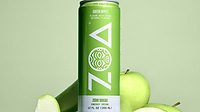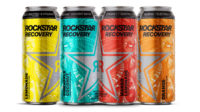Energy drink category expands offerings, appeals to broader base
Sugar reduction, health and wellness trends prompt innovation

Image courtesy of Odyssey
Cambridge Dictionary defines the word popularity as “the fact that something or someone is liked, enjoyed or supported by many people.” Yet, because popularity is a social phenomenon that can be ascribed to objects that people interact with, experts beyond sociologists are delving into why some products catch on and become popular while others waver.
When it comes to the popularity of energy drinks within the beverage market, market research shows that health and wellness trends are factors driving the success of the category. However, with the blurring of lines in functional beverages, the category is facing some competition, experts note.
Sally Lyons Wyatt, global executive vice president and chief adviser for consumer packaged goods and foodservice at Chicago-based Circana, notes that what’s interesting about energy drinks is that the category has risen above the clouds of blurriness in the functional beverage market.
“Energy is definitely coming through with strong unit and dollar sales,” she says. “But you’ve seen so many different categories, whether it be water, whether it be soft drinks, whether it be dairy products, all trying to get into what would be this functional beverage space.”
According to Circana data, the total energy drink category was just shy of $21.9 billion in sales, an increase of 9.5%, in U.S. multi-outlets and convenience stores for the 52 weeks ending June 19. Meanwhile, unit sales were up 6.9% for the same time period.
Top non-aseptic energy drinks (Individual brands)
Source: Circana, Chicago. Total U.S. supermarkets, drug stores, gas and convenience stores, mass merchandisers, military commissaries, and select club and dollar retail chains for the 52 weeks ending June 19.
Sydney Riebe, analyst for food and drinks reports at Mintel, Chicago, notes that the strong performance for the energy drink and shots category this past year has been driven almost exclusively by energy drinks.
“Energy drink growth is on par with other functional drink categories like sports and nutrition drinks,” Riebe says. “While a smaller market, the performance drink category is growing more rapidly, focusing on health as well as energy enhancing claims that indicate a continued blurring of categories due to common consumer interests across beverages.”
Roger Dilworth, senior analyst at Beverage Marketing Corporation (BMC), Wintersville, Ohio, explains that despite energy shots’ decline — approximately 2-3% in terms of both volume and retail dollar sales — the overall energy drink category showed strong growth in the past year.
“Energy drinks grew volume by about 6% in 2023 and retail dollars by around 13%, much stronger than sports drinks and a little slower than protein drinks,” he says.
Standing out from the crowd
With continued blurring of the lines and more consumers looking to functional beverages to support well-being, experts weigh in on how the energy drink category can further meet consumers’ various need states.
Circana’s Lyons Wyatt suggests making products more accessible and available where consumers are for different moments around the day.
“I would say that there are functional beverages that cater to consumers that are on a well-being journey and it could be for pre-, during or post workout,” she says. “But energy drinks kind of fit more toward an extra boost through the day… and that might mean, ‘I need a boost to get through my fitness routine.’ … And I think what some companies have done well is made it accessible when and where consumers might be considering a functional beverage.”
Mintel’s Riebe points to consumers’ growing demand for drinks with natural ingredients and health claims such as hydration as driving innovation.
“Consumer interest in health has driven the energy drink market toward more natural, functional and fitness-oriented products that are marketed as a lifestyle and are attracting traditionally less engaged category consumers like younger women,” she says.

Further, Riebe notes how sugar reduction trends are impacting the energy drinks and shots market.
“With around one-third of U.S. adults who have decreased energy drink consumption citing concerns with sugar as the reason, it is not surprising that the North American market has responded with over half of new product launches carrying the sugar-free claim in the past year,” she says. “An overall rise in the use of natural sweeteners and improvement of their tastes look to make sugar-free options more appealing.”
BMC’s Dilworth echoes similar sentiments, noting the increased popularity of low- and no-sugar drinks.
“More consumers are gravitating toward zero- and low-calorie energy drinks,” he says. “Like in the CSD segment, marketers are downplaying any reference to ‘diet.’”
Circana’s Lyons Wyatt notes that energy drinks with no-, low- or less sugar claims grew in dollar sales 22%, with unit sales up 19% in U.S. multi-outlets and convenience stores for the 52 weeks ending May 19.
“... That is really incredible growth when you’re talking about you know one in 2% volume growth,” she says. “Getting double digit anything these days is amazing.”
Aside from sugar reduction trends, broader health trends also are impacting the market.
BMC’s Dilworth notes a shift in the category toward general health attributes.
“It seems that there’s been a slight shift from emphasizing sports drink cues such as branched chain amino acids and more toward general health attributes such as immunity and brain health,” he says. “It’s not a full-on trend yet, but the direction seems to be toward nootropic and focused energy, particularly as some energy drink consumers grow older.”
Mintel’s Riebe echoes similar sentiments, noting that functional needs like cognitive enhancement and stress reduction are influencing category innovation.
“Additionally, younger consumers are increasingly interested in customizable beverages, including varying caffeine levels, textures and the ability to mix and match flavors,” she says. “Globally, Gen Z consumers are particularly interested in bold and unique flavor combinations, such as red grape sour watermelon and yuzu flavor combinations. Flavors that borrow from other beverages like Earl Grey, green tea and ginger are also entering the category.”
Riebe adds that in the U.S. market, energy drinks are incorporating flavors that evoke nostalgia and fun like frosted grape, blue raspberry, lollipop and gummy worm.
Circana’s Lyons Wyatt also notes how candy flavors are popular among younger consumers, with the market also seeing growth with flavors such as Mandarin marshmallow, green apple and cherry.
What’s in store
Although consumer trends continue to prompt innovation within the energy drink category, experts note that the market is not without its challenges.
“Many energy drink consumers are mid-to-lower income and a deteriorating economy may cut into sales in the short term,” BMC’s Dilworth days. “Energy shots continue to be challenged by their limited usage occasions and innovation potential.”
Mintel’s Riebe notes how the market is becoming increasingly competitive with adjacent beverage categories intruding on the energy drinks’ territory by offering similar energy-boosting propositions.
“This category blurring intensifies the competition and makes it harder for energy drinks to differentiate themselves,” she explains. “Additionally, younger consumers like Gen Z and millennials are highly engaged with energy drinks but are also more scrutinizing about the ingredients (i.e., sugar and caffeine levels) and benefits.”
Circana’s Lyons Wyatt suggests that, because the energy drink category is a young category compared with other categories that have been around for decades, offering a variety of options is key to appealing to a broader base.

“Coming out with varieties that are a little more transparent, that have ingredients that give people options, and that are educating consumers around what these ingredients can do for them, I think those [factors] are so incredibly important,” she says. “… Yet, at the same time just good old fashioned energy drinks are seeing solid growth too. So I think what it’s pointing toward is that the more variety, more types that are out there, then [the category] is going to appeal to a broader base and continue to have growth.”
Looking ahead, Mintel’s Riebe anticipates continued innovation in flavor, health and functional benefits and the blurring of beverage categories, allowing energy drinks to capture non-traditional occasions.
“In the United States, the energy drink market is expected to continue its strong performance, with estimated annual growth between 6-9% over the next five years,” she says.
For 2024, BMC’s Dilworth notes that energy drinks are projected to grow at a 5-6% rate in volume and retail dollars, while energy shots are expected to continue their modest declines.
Circana’s Lyons Wyatt suggests that the amount of growth will be dependent on whether the industry continues to innovate, offering varieties of flavors, varieties of sugar options and varieties of caffeine options.
I think the category will continue to have very strong growth, but it will be dependent on accessibility, Lyons Wyatt says.
“[By] having these drinks available and the varieties available in places where consumers are outdoors, indoors at home, away from home, the [category] will continue to see strong growth for the next few years,” she concludes.
Looking for a reprint of this article?
From high-res PDFs to custom plaques, order your copy today!






